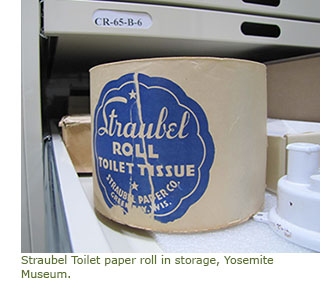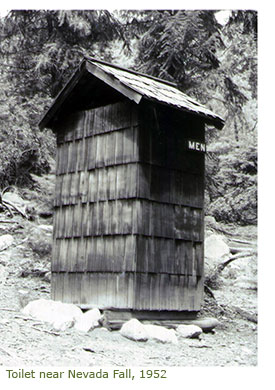 The last thing I ever thought I would find stowed neatly in an industrial storage cabinet of the Yosemite Museum's air-controlled, alarm-guarded, white-cotton-glove-required Collections Room—was toilet paper. Not stacked up or out in the open for the nervous intern to use when trying to get that little spot of dust off the corner of a Bierstadt frame, but preserved among the great treasures and artifacts of Yosemite. As I was poking around to find the next object to investigate and blog about, I saw it, sitting there with the assumed dignity of being treasured, like a child wearing an oversized king's robe and suddenly ordering his pet cat to fetch him some milk. Toilet paper…seriously? Seriously. The Yosemite Museum takes its purpose very seriously—to preserve the physical pieces of history of this great place and its people—which could be why the toilet paper is not actually even officially catalogued into the collection. But it's still there in that cabinet and deserves a musing or two. Perhaps this object, at once so quotidian and yet so bizarre in context, could help us see something really great about our national parks. Perhaps, all bathroom jokes aside, this toilet paper deals with some serious business.
The last thing I ever thought I would find stowed neatly in an industrial storage cabinet of the Yosemite Museum's air-controlled, alarm-guarded, white-cotton-glove-required Collections Room—was toilet paper. Not stacked up or out in the open for the nervous intern to use when trying to get that little spot of dust off the corner of a Bierstadt frame, but preserved among the great treasures and artifacts of Yosemite. As I was poking around to find the next object to investigate and blog about, I saw it, sitting there with the assumed dignity of being treasured, like a child wearing an oversized king's robe and suddenly ordering his pet cat to fetch him some milk. Toilet paper…seriously? Seriously. The Yosemite Museum takes its purpose very seriously—to preserve the physical pieces of history of this great place and its people—which could be why the toilet paper is not actually even officially catalogued into the collection. But it's still there in that cabinet and deserves a musing or two. Perhaps this object, at once so quotidian and yet so bizarre in context, could help us see something really great about our national parks. Perhaps, all bathroom jokes aside, this toilet paper deals with some serious business. Global customs in the washroom
Cleaning up after oneself has been both a unifying and dividing activity since humans began roaming the earth. Of course back then, they were probably more worried about survival than hygiene. But as societies developed, customized bathroom-etiquette began to take shape. If not the hand itself, the most common solution was to grab what was at hand: from shells and rocks to corncobs, leaves, snow, wool, grass, and hay. Some got creative. The ancient Greeks primarily used clay and stone and the Romans engineered the mechanism of a stick with a sponge attached. Soon after the invention of paper in Han Dynasty China (202 BCE to 220 CE), the first record of paper being used in the bathroom came in 589 CE from Chinese scholar-official Yan Zhitui (531-591 CE). And while all nations were finding their own ways, not all latched on to the paper idea. Elsewhere, the wealthy were wiping with other materials, either those listed above or rags, wood shavings, maize, apple plant husks, fruit skins, or any number of materials depending on resources, weather, and customs. In many parts of the world, particularly some regions in India, the Middle East, and Asia, flushing water and toilet paper were, and still are, unavailable or unaffordable. In Europe and some Asian countries today, paper is considered not as clean and hygienic as water-cleaning through bidets and moist alternatives.
Bringing us together and the story of this roll
But, as any scientist will tell you, where paper spread, it spread like wildfire. In 1857, an Albany, New York entrepreneur named James Gayetty invented aloe-infused sheets of manila hemp designed for bath tissue and advertised as preventing hemorrhoids. The Yosemite Museum's roll is from the Straubel Paper Company,  established in 1907 in Wisconsin. In 1928, the Hoberg Paper Company established the Charmin brand, with dainty and beautiful women on its label. Since then, toilet paper has become so ubiquitous in the United States that it is a modern-day necessity. Americans spend $6 million a year on toilet paper and each uses about 50 pounds of the stuff per year. We all need it. This one roll in the Yosemite Museum Collections Room is a reminder of all the backpackers and hikers and adventurers who have trekked out into the wilderness away from all other people, but still carried one thing that sewed them snuggly into society. No matter where we come from or what we do back there, when we set out on that trail, we all have a few sheets of white paper neatly packed in our bags. We have needs that the wilderness is sometimes too uncomfortable—or poisonous—to accommodate. Toilet paper grounds us in humble realities and bonds us by something we seldom talk about. Taboo? Perhaps. Beautiful? Maybe just a little bit.
established in 1907 in Wisconsin. In 1928, the Hoberg Paper Company established the Charmin brand, with dainty and beautiful women on its label. Since then, toilet paper has become so ubiquitous in the United States that it is a modern-day necessity. Americans spend $6 million a year on toilet paper and each uses about 50 pounds of the stuff per year. We all need it. This one roll in the Yosemite Museum Collections Room is a reminder of all the backpackers and hikers and adventurers who have trekked out into the wilderness away from all other people, but still carried one thing that sewed them snuggly into society. No matter where we come from or what we do back there, when we set out on that trail, we all have a few sheets of white paper neatly packed in our bags. We have needs that the wilderness is sometimes too uncomfortable—or poisonous—to accommodate. Toilet paper grounds us in humble realities and bonds us by something we seldom talk about. Taboo? Perhaps. Beautiful? Maybe just a little bit.
